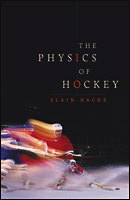 Slippery science Slippery science |
Slippery science
Why is ice slippery? Alain Haché has two kinds of first-hand knowledge. A veteran amateur hockey goalie, he learned to skate outdoors on frozen ponds. As a professor of physics at the University of Moncton in New Brunswick, Canada, he has combined his professional and personal passions in The Physics of Hockey (Johns Hopkins University Press, 2002; Raincoast Books, Vancouver; a Finnish edition,Jääkiekon fysiikka, is published by Terra Cognita in Helsinki).
"The collisions in hockey are probably most similar to particle physics," said Haché, in his distinctive French-Canadian accent, "but there are many physics aspects to hockey, maybe even more than other sports."
Ice is the prime differentiating ingredient, with players skating at 30 mph and launching slap shots at 100 mph on a frozen surface about ¾ of an inch thick, maintained at about 16°F. "The physics of ice is condensed matter physics, and what happens at the surface of ice is fascinating," said Haché. "Many people have wondered for a long time what makes ice slippery. We've only recently learned the reasons, using powerful atomic force microscopy."
At the macroscopic level, materials like wood and plastic have a coefficient of friction around 0.5; ice has a coefficient of friction of 0.005, which Haché said might be matched only by biological structures such as the joint in a knee. He added that traditional models of ice's slipperiness—surface melting caused by the pressure of a skate blade or friction rubbing from the blade's motion—offer insignificant temperature changes. But atomic force microscopy, which offers resolution on the order of fractions of an ångstrom (0.1 nanometer), provides a compelling new vision of ice formation.
"The top layer of ice is a bulk crystalline structure arranged like the structure of graphite," Haché said. "At the top of the ice the molecules are tightly bound but below them are dangling bonds that are very mobile. So the first few layers at the very top are not quite solid, and not liquid, but something in between. This semi-wet layer or film exists whether or not there is pressure, and whether or not there is friction rubbing, down to something like -200°F. Below this semi-wet layer the coefficient of friction is about 0.6, so ice is like plastic or wood below the surface. But the semi-wet top layer that lowers friction is a property of the ice itself."
The book had its origins at a physics conference, when Haché struck up a conversation with someone who happened to be an editor. "He said, 'You must be Canadian. Do you play hockey?'" Haché recalled. "When I said I did, he said, 'There's a book I'd like someone to write.' Nothing really came of it for a while, but then I wrote half a chapter and sent it to him. He liked it, and there we went."
Mike Perricone
Click here to download the pdf version of this article.






